New Account | Seed Mix |
Gift Certificates |AAS Winners |
Gardening Products
SEEDS: Unusual | Annuals | Perennials | Vegetables | Herbs | Trees
Flower Garden Plants for Shady Areas

LET978 Baby Orange
This bright orange Impatiens will bloom its heart out for you! Grown from high quality flower seed, this plant has extremely uniform growth with high yields of lovely 2 inch orange blooms on rich, green foliage.
Brighten your shaded garden areas with the vibrant Baby Orange Impatiens. Thriving at heights of 8–10 inches, these indoor plant seeds are perfect for containers, borders, or baskets. Their spring-to-fall bloom season ensures a long-lasting display. Whether you’re planting in shaded spots or using them as indoor flower seeds, this collection adds effortless beauty.
Brighten your shaded garden areas with the vibrant Baby Orange Impatiens. Thriving at heights of 8–10 inches, these indoor plant seeds are perfect for containers, borders, or baskets. Their spring-to-fall bloom season ensures a long-lasting display. Whether you’re planting in shaded spots or using them as indoor flower seeds, this collection adds effortless beauty.

1A342 Shady Flower Mix
This is a wonderful mix for shady areas. Turns troublesome shady spots into beautiful patches of wildflowers that will attract butterflies and bees. A wonderful mix of flowers: Columbine, Bellflower, Shasta Daisy, Chinese Houses, Coreopsis, Monkey Flower, Forget-Me-Nots, Larkspur, Sweet William, Purple Coneflower, Baby's Breath, Candytuft, Snapdragon, Baby Blue Eyes, Poppy Mix and Johnny Jump-Up.
15g pack will cover 100 sq. ft.
15g pack will cover 100 sq. ft.

JB119 Pink Polka Dot
Grown for its variegated, attractive foliage, use this delightful plant indoors as a perennial or outdoors in the shade garden as an annual. Pink Polka Dot plant grows readily from flower seeds and will reach just 8-12 inches tall and 9 inches wide. One of the most effortless house plants or shade plants you will ever grow. An annual foliage plant (or greenhouse perennial), it springs right up from flower seed, quickly reaching its mature size. The large, pointed leaves arise from the central stem, creating a neat rosette that looks lovely in the front of the border or in containers of all sizes. The foliage is dark green very heavily splattered with light pink, so that on most leaves, only the midrib and veining remain green.
Pink Polka Dot is a great choice to mix in with other foliage plants in the shade. Its pink will sure stand out amongst other plants and give your beds a unique look. Pink Polka Dot will give months of color and enjoyment in the house too!
Pink Polka Dot is a great choice to mix in with other foliage plants in the shade. Its pink will sure stand out amongst other plants and give your beds a unique look. Pink Polka Dot will give months of color and enjoyment in the house too!

JB116 Lady's Mantle ( Alchemilla mollis )
This popular flower is perfect for the garden. With its olive colored, crimped velvety leaves which cup to capture the dew and rain and its frothy sprays of yellow clusters, it is certainly appealing to the eye. The Achemilla Mollis plant is bushy and makes an excellent border or edging plant. The Lady's Mantle flowers are excellent for cutting, and the yellow blooms work in nicely in flower arrangements
Lady’s mantle is an interesting plant to add to the garden, especially in shady borders. It is also commonly used as a ground cover and makes a nice edging when kept in bounds. You may find lady’s mantle in wreaths and bouquets as well, either freshly cut or dried.
The name alludes to the fanlike shape of this plant's light green foliage. A cottage garden classic, it produces masses of tiny, greenish-yellow blooms that erupt from fan-shaped foliage. Extremely drought tolerant and an excellent cover plant, it will thrive in sun or shade; a wonderful companion for roses. Long lasting as cut flowers. A perennial for zones 3-8, growing in clumps about 20 inches tall.
Lady’s mantle is an interesting plant to add to the garden, especially in shady borders. It is also commonly used as a ground cover and makes a nice edging when kept in bounds. You may find lady’s mantle in wreaths and bouquets as well, either freshly cut or dried.
The name alludes to the fanlike shape of this plant's light green foliage. A cottage garden classic, it produces masses of tiny, greenish-yellow blooms that erupt from fan-shaped foliage. Extremely drought tolerant and an excellent cover plant, it will thrive in sun or shade; a wonderful companion for roses. Long lasting as cut flowers. A perennial for zones 3-8, growing in clumps about 20 inches tall.


TPF255 Forget-Me-Not ( Myosotis Sylvatica )
One of the all-time world favorites among wildflowers often used at funerals. Forget-me-nots received their name based on the romantic legend: a medieval knight, gathering blue flowers along a stream for his lady love, was suddenly swept away by flood waters. As he disappeared, he tossed the bouquet to his lady with the immortal words, "Forget me not."
Myosotis Sylvatica seeds will grow in all regions of North America and is very easy to establish. Blue Forget Me Not flowers will grow in sun or shade and will start to bloom early. In nature, this species grows wild in stream-beds and wet woodlands. So, in your garden, it prefers lots of moisture, and has good shade tolerance. Forget-me-not is low-growing and makes a nice ground cover plant as well as edging for the front of the border or even in containers.
How to grow Forget Me Not seeds: Myosotis Sylvatica seeds can be started either indoors or directly outside in a prepared seedbed. Indoors, in the late winter, sow Forget Me Not seeds in starter flats, and press the flower seeds into the soil and lightly cover. For directly sowing outdoors, prepare a seedbed by loosening the top several inches of soil and weeding. The Forget-Me-Not seeds can be sown when frosts are still possible. Thin the seedlings to 9 - 12 inches apart. Forget-me-not plants are liberal self-sowers. To encourage reseeding, leave spent flowers on the plant well until after they have faded. The Forget Me Not flower seeds will drop and produce more ground cover plants the next spring.
Myosotis Sylvatica seeds will grow in all regions of North America and is very easy to establish. Blue Forget Me Not flowers will grow in sun or shade and will start to bloom early. In nature, this species grows wild in stream-beds and wet woodlands. So, in your garden, it prefers lots of moisture, and has good shade tolerance. Forget-me-not is low-growing and makes a nice ground cover plant as well as edging for the front of the border or even in containers.
How to grow Forget Me Not seeds: Myosotis Sylvatica seeds can be started either indoors or directly outside in a prepared seedbed. Indoors, in the late winter, sow Forget Me Not seeds in starter flats, and press the flower seeds into the soil and lightly cover. For directly sowing outdoors, prepare a seedbed by loosening the top several inches of soil and weeding. The Forget-Me-Not seeds can be sown when frosts are still possible. Thin the seedlings to 9 - 12 inches apart. Forget-me-not plants are liberal self-sowers. To encourage reseeding, leave spent flowers on the plant well until after they have faded. The Forget Me Not flower seeds will drop and produce more ground cover plants the next spring.

SF240 Ramosa ( Cimicifuga Ramosa Atropurpurea )
A wonderful perennial plant for zones 3-8b, growing about 5 feet tall when mature.
A wonderful partial shade plant. If you enjoy tall, stately, dark perennials with fragrant flower spikes, consider starting Cimicifuga seeds and growing this remarkably beautiful plant. With intensely colored foliage of reddish purple and ivory white flowers, this is one perennial that creates a breathtaking display.
Commonly called Bugbane, this dark foliage plant thrives in partial shade and moist, organically enriched soil. Bugbane plants are slow to establish and can take several years to reach their full height of 6 feet. Needs consistently moist soil. Cimicifua seeds will need a cold, moist stratification.
A wonderful partial shade plant. If you enjoy tall, stately, dark perennials with fragrant flower spikes, consider starting Cimicifuga seeds and growing this remarkably beautiful plant. With intensely colored foliage of reddish purple and ivory white flowers, this is one perennial that creates a breathtaking display.
Commonly called Bugbane, this dark foliage plant thrives in partial shade and moist, organically enriched soil. Bugbane plants are slow to establish and can take several years to reach their full height of 6 feet. Needs consistently moist soil. Cimicifua seeds will need a cold, moist stratification.

TRZ044 Wild Ginger ( Asarum canadense )
Best known for its use as an attractive, low-growing ground cover in a shaded woodland setting, Wild Ginger is also deer-resistant. It enjoys shaded, moist, somewhat acidic soils and will grow 6" in height and the large heart-shaped leaves can be 6" in diameter. The leaves are shiny when fully opened and the stems are hairy. Unlike many early spring woodland plants, Wild Ginger will keep its foliage throughout the season; it will not go dormant so it is a good species to plant among the spring ephemerals that do go dormant. An attractive dark red flower will appear under the plant early spring but will fade fairly quickly.
Although unpalatable to deer and other mammals, it is an important food source for the Pipevine swallowtail Butterfly. Many insects are attracted to Wild Ginger, including ants, believed to pollinate the plant.
Many Native American Indian tribes used the root of the Wild Ginger plant as a seasoning or to treat colds and fevers. European Settlers to this continent also learned to use the root as a flavor substitute to the tropical ginger they were used to. Other common names include Woodland Ginger, Ginger Root, Heart Snakeroot, Indian Ginger, Asarabaca, and Catfoot. For zones 4-8.
Seeds need a warm, moist period followed by a cold, moist period Mix seeds with sterile media. Place mixture in a sealed plastic bag in a warm place (about 80°F) for 60 to 90 days. Then place in refrigerator (33- 38°F) for 60 to 90 days before sowing. Or, sow outdoors and allow one full year for germination.
Although unpalatable to deer and other mammals, it is an important food source for the Pipevine swallowtail Butterfly. Many insects are attracted to Wild Ginger, including ants, believed to pollinate the plant.
Many Native American Indian tribes used the root of the Wild Ginger plant as a seasoning or to treat colds and fevers. European Settlers to this continent also learned to use the root as a flavor substitute to the tropical ginger they were used to. Other common names include Woodland Ginger, Ginger Root, Heart Snakeroot, Indian Ginger, Asarabaca, and Catfoot. For zones 4-8.
Seeds need a warm, moist period followed by a cold, moist period Mix seeds with sterile media. Place mixture in a sealed plastic bag in a warm place (about 80°F) for 60 to 90 days. Then place in refrigerator (33- 38°F) for 60 to 90 days before sowing. Or, sow outdoors and allow one full year for germination.

SF015 Aquilegia "McKana Giants ( Aquilegia caerulea )
Columbines are one of the most beautiful and elegant of
perennials. 'McKana Giants' are a long spurred variety, growing
up to 3 ft with large blooms in a very bright range of single
and bi-colours. Seen in a group these flowers look almost
unreal or other-worldly. Very dramatic. The hummgbird loves
this perennial which can be easily grown in sun to part shade
in fertile, moist, well-drained soil. Long flowering from early
summer and onward. Perennial.
Color: Wide Range Zone: 2-9 Spacing: 24" Height:36" Start Seeds: Late Winter, for transplanting outside in Spring.
Color: Wide Range Zone: 2-9 Spacing: 24" Height:36" Start Seeds: Late Winter, for transplanting outside in Spring.

JB139 Super Rainbow Master Mix
Exotic looking, they perform well as shade garden plants, as well as in pots and containers. Outstanding mixture; the best and brightest colors of medium-sized leaf varieties. Grown for its brilliant, glowing foliage rather than flowers. This is an outstanding mixture formulated to provide the best and brightest colors of medium-sized leaf varieties. Spectacular for beds and borders.
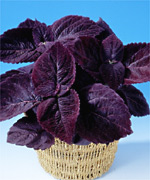
IP218 Giant Exhibition Palisandra
Originally selected as a houseplant, Giant Exhibition Palisandra is also a fine specimen in the shade garden, and is just the right size for containers.
Soft, neatly serrated burgundy-maroon leaves are 6 inches long and up to 4 inches wide.
Soft, neatly serrated burgundy-maroon leaves are 6 inches long and up to 4 inches wide.
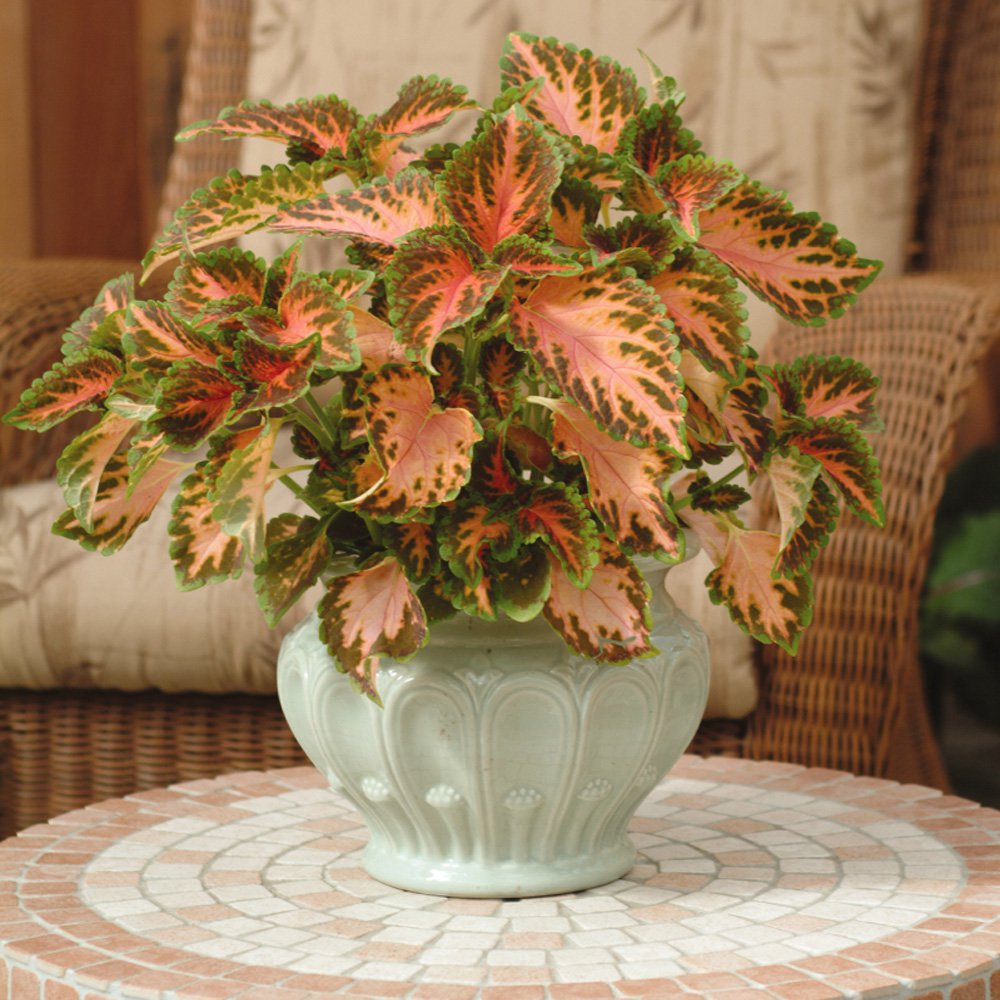
JB171 Wizard Coral Sunrise
Growing the awesome annuals from flower seeds is so fun and rewarding, and you can fill your landscape with these wonderful foliage plants! Often called Painted Leaf, Coleus plants feature colorful, exotic leaves that do well in sun or shade. These Coleus plants are compact with medium-size leaves, and they combine beautifully with other varieties for colorful containers and baskets.

SF343 Wizard Wave
Start Coleus seeds for this exotic foliage plant that never disappoints! Wizard Jade has ivory at the center of the leaves and greens around the edges. It's a beautiful plant for shade that can be mixed in containers with other shade loving plants. Starting the flower seeds indoors in the late winter will provide you with Coleus seedlings for planting outdoors in beds or containers in the spring once frosts have passed. Or, keep a Coleus houseplant in a sunny window or under artificial lights for the exotic beauty indoors!

JB197 Chinese Foxglove ( Rehmannia elata )
Winner of the RHS Award of Garden Merit. Commonly called Chinese foxglove because the tubular flowers bear a resemblance to digitalis ( foxglove ). Pollinators love the trumpet-shaped flowers, which are a lovely shade of rose-pink with speckled yellow throats. The blooms dangle from slender stems that rise above a basal rosette of scalloped gray-green foliage. The airy and delicate blossoms of combine grace and color with a long season of bloom.
Easy to grow, it is a perennial but might not survive above zone 7 so grow it there as an annual. Blooms prolifically first year from seed if sown the previous fall. No garden should be without this lovely plant, it looks both dainty and really exotic.
Although Chinese foxglove is not as hardy as its lookalike, digitalis, it is more versatile, growing well in shade and is even fairly drought-tolerant. Mature Height: 24-36", Spacing: 12-18". Zones 7-10.
Easy to grow, it is a perennial but might not survive above zone 7 so grow it there as an annual. Blooms prolifically first year from seed if sown the previous fall. No garden should be without this lovely plant, it looks both dainty and really exotic.
Although Chinese foxglove is not as hardy as its lookalike, digitalis, it is more versatile, growing well in shade and is even fairly drought-tolerant. Mature Height: 24-36", Spacing: 12-18". Zones 7-10.
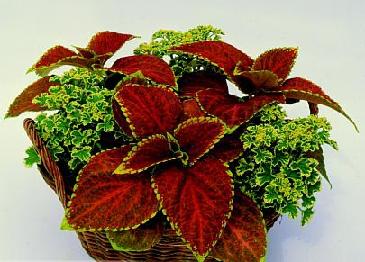
SF382 Giant Exhibition Rustic Red
This stunning Giant Exhibition Coleus is utterly distinctive, bearing large, neatly serrated, rusty-red leaves with stitched yellow edges. It's dazzling on its own or complements others beautifully when in a mixed planting, and it's suitable for indoor or outdoor growth in partial to full shade. This makes a wonderful houseplant!
These plants reach 12 to 15 inches high and wide, with leaves about 6 to 7 inches long and 4 inches wide at the base. You'll love its vigor, compact habit, and uniform color! 'Rustic Red' is a snap to grow, germinating readily from seed any time of year indoors. For bushier, fuller plants, keep the growing tips pinched.
These plants reach 12 to 15 inches high and wide, with leaves about 6 to 7 inches long and 4 inches wide at the base. You'll love its vigor, compact habit, and uniform color! 'Rustic Red' is a snap to grow, germinating readily from seed any time of year indoors. For bushier, fuller plants, keep the growing tips pinched.
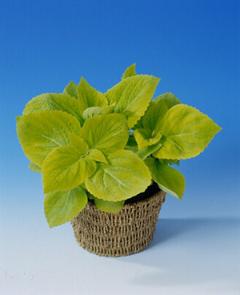
SF414 Giant Exhibition Limelight
Limelight is a delightful little plant, with a perfectly rounded habit and neat rosettes of serrated leaves. It looks tailor-made for a pot or basket, but also cools down the garden in beds, borders, and even as edging! It grows in a snap from seed (wait till you see the tiny scalloped leaves on new seedlings!) and lasts and lasts!
Limelight is one of the Giant Exhibition Series, a group of heirloom Coleus re-selected for better vigor, more uniform colors, and neater habit. These Coleus were at the heart of the "Coleus craze" that swept England around the turn of the last century -- they were grown and adored by all, their brilliantly-colored leaves offering unheard-of winter color indoors. Well, things haven't changed much -- these gorgeously-sculpted 6- to 7-inch-long, 4-inch-wide leaves still make hearts flutter and gardens glow!
Limelight is one of the Giant Exhibition Series, a group of heirloom Coleus re-selected for better vigor, more uniform colors, and neater habit. These Coleus were at the heart of the "Coleus craze" that swept England around the turn of the last century -- they were grown and adored by all, their brilliantly-colored leaves offering unheard-of winter color indoors. Well, things haven't changed much -- these gorgeously-sculpted 6- to 7-inch-long, 4-inch-wide leaves still make hearts flutter and gardens glow!

JB071 Giant Exhibition Multicolor
Green edge, white center, all splashed red, novel look for a coleus. Old fashioned, large wide leaf, striking colors, for large container or landscape. Also does well in shade.

2239 Echinacea Magnus ( Echinacea purpurea )
Perennial. 1998 Perennial Plant Winner. Blooms All Summer Long!
Extra-large, hot-pink blooms up to 7 inches across, with petals
held out flat (instead of recurved), plus easy-care and
drought-tolerant. Magnus reaches 31/2 feet tall in full sun to
light shade, blooms from June through September!
Color: Hot Pink Zone:2-9 Spacing: 12" Height:3-4 feet. Start Seeds: Anytime of year inside, for transplanting outside in Spring.
Color: Hot Pink Zone:2-9 Spacing: 12" Height:3-4 feet. Start Seeds: Anytime of year inside, for transplanting outside in Spring.

TWT208 Redwood ( Gaultheria procumbens 'Redwood' )
A delightful decorative fruit / medicinal plant that makes a good flowering pot plant.
Creeping shrub that grows 6 inches tall with scalloped, glossy dark green leaves. Blooms urn shaped white or pale pink flowers in summer that mature to scarlet fruit.
Plant in an area that receives light shade, or remains shaded throughout the day. Shade tolerant, but will not tolerate drought. Excellent choice for native gardens, and functions as a woodland ground cover.
Makes a nice container plant for shaded patio areas. Excellent ground cover for shady areas. Woodland gardens, rock gardens, foundations or native plant areas. Plants are an interesting complement to other acid-loving shrubs such as azaleas, rhododendrons, kalmias and blueberries.
Creeping shrub that grows 6 inches tall with scalloped, glossy dark green leaves. Blooms urn shaped white or pale pink flowers in summer that mature to scarlet fruit.
Plant in an area that receives light shade, or remains shaded throughout the day. Shade tolerant, but will not tolerate drought. Excellent choice for native gardens, and functions as a woodland ground cover.
Makes a nice container plant for shaded patio areas. Excellent ground cover for shady areas. Woodland gardens, rock gardens, foundations or native plant areas. Plants are an interesting complement to other acid-loving shrubs such as azaleas, rhododendrons, kalmias and blueberries.
Foliage was once used to make oil of wintergreen which has astringent, stimulant and diuretic properties. Wintergreen has been a popular flavoring for chewing gum, candies and toothpaste. Dried leaves can be used to make an interesting tea (teaberry is a sometimes-used common name for this plant), but this usage is no longer recommended. Leaves were once made into poultices for arthritic pain and sore muscles. Fruits may be eaten raw or added to pastries and salads.

TWT138 Rodger's Flower ( Rodgersia Henrici Hybrids
)
Rodgersias have bold textured leaves that take on beautiful red and bronze tones in the fall. The flowers are a fluffy rose pink that are held high above the foliage and then followed by interesting seed heads. The course foliage makes it excellent as a specimen plant. Give them planty of room as they will become massive in size once established.
With its bold, divided leaves this forms an exotic-looking clump that adds a unique foliage accent to any moist border. Large airy plumes of soft-pink to rose-purple flowers appear in early to mid-summer, and these are useful for cutting or even drying.
Slowly gaining popularity as a unique plant in the shade garden, used primarily as a specimen, foliage has a coarse texture unlike many other shady perennials, does not like heavy clay soil. Bold, hardy, large fingered leaf with puffy bright pink blooms for moist areas as well. Grows 30 inches tall, hardy for zone 3 and higher.
With its bold, divided leaves this forms an exotic-looking clump that adds a unique foliage accent to any moist border. Large airy plumes of soft-pink to rose-purple flowers appear in early to mid-summer, and these are useful for cutting or even drying.
Slowly gaining popularity as a unique plant in the shade garden, used primarily as a specimen, foliage has a coarse texture unlike many other shady perennials, does not like heavy clay soil. Bold, hardy, large fingered leaf with puffy bright pink blooms for moist areas as well. Grows 30 inches tall, hardy for zone 3 and higher.

IP247 Goat's Beard ( Aruncus dioicus )
Tall, graceful, robust perennial plant with creamy white plumes
for shade, summer bloom. Plant in rich, moist soil in full sun
to partial shade. Grows 4-5' tall. Flowers in summer. Hardy in
Zones 3-8.
Excellent background plant for shady, moist spots in the border or in a woodland, wild or native plant garden. Plant as a specimen or in groups along streams or water gardens.
Excellent background plant for shady, moist spots in the border or in a woodland, wild or native plant garden. Plant as a specimen or in groups along streams or water gardens.

TWT271 Noble Spirits ( Aruncus aethusifolius )
For a decorative, fern-like foliage and white flower spikes in late spring, start Aruncus seeds and enjoy this perennial for part sun. Similar to Astilbe, Aruncus is excellent for the shady landscape, and the foliage stays attractive all season long. Commonly, it is known as Dwarf Goat's Beard or Dwarf Korean Goatsbeard, and it's a great choice for a woodland garden or rock garden in part shade. How to Grow Goatsbeard: Aruncus seeds do best with a cold/moist stratification before sowing. Grows about 12 inches tall, hardy for zones 3-9.

JB194 Pink False Goats Beard ( Astilbe Chinensis Pumila )
Produces the most versatile Astilbe we know of. It creates a wonderful ground cover for moist, shaded areas and is more tolerant of heat and temporary drought than other Astilbe plants. The foliage is a bronze-green color, and is topped with petite, rosy-pink plumes. Astilbe perennials are clump-forming and feature graceful, fern-like mounds of lovely foliage with plume-like flower panicles rising above the foliage on slender, upright stems. Grows 10" tall. Perennial for zones 4-8.

SF015 Aquilegia "McKana Giants ( Aquilegia caerulea )
Columbines are one of the most beautiful and elegant of
perennials. 'McKana Giants' are a long spurred variety, growing
up to 3 ft with large blooms in a very bright range of single
and bi-colours. Seen in a group these flowers look almost
unreal or other-worldly. Very dramatic. The hummgbird loves
this perennial which can be easily grown in sun to part shade
in fertile, moist, well-drained soil. Long flowering from early
summer and onward. Perennial.
Color: Wide Range Zone: 2-9 Spacing: 24" Height:36" Start Seeds: Late Winter, for transplanting outside in Spring.
Color: Wide Range Zone: 2-9 Spacing: 24" Height:36" Start Seeds: Late Winter, for transplanting outside in Spring.
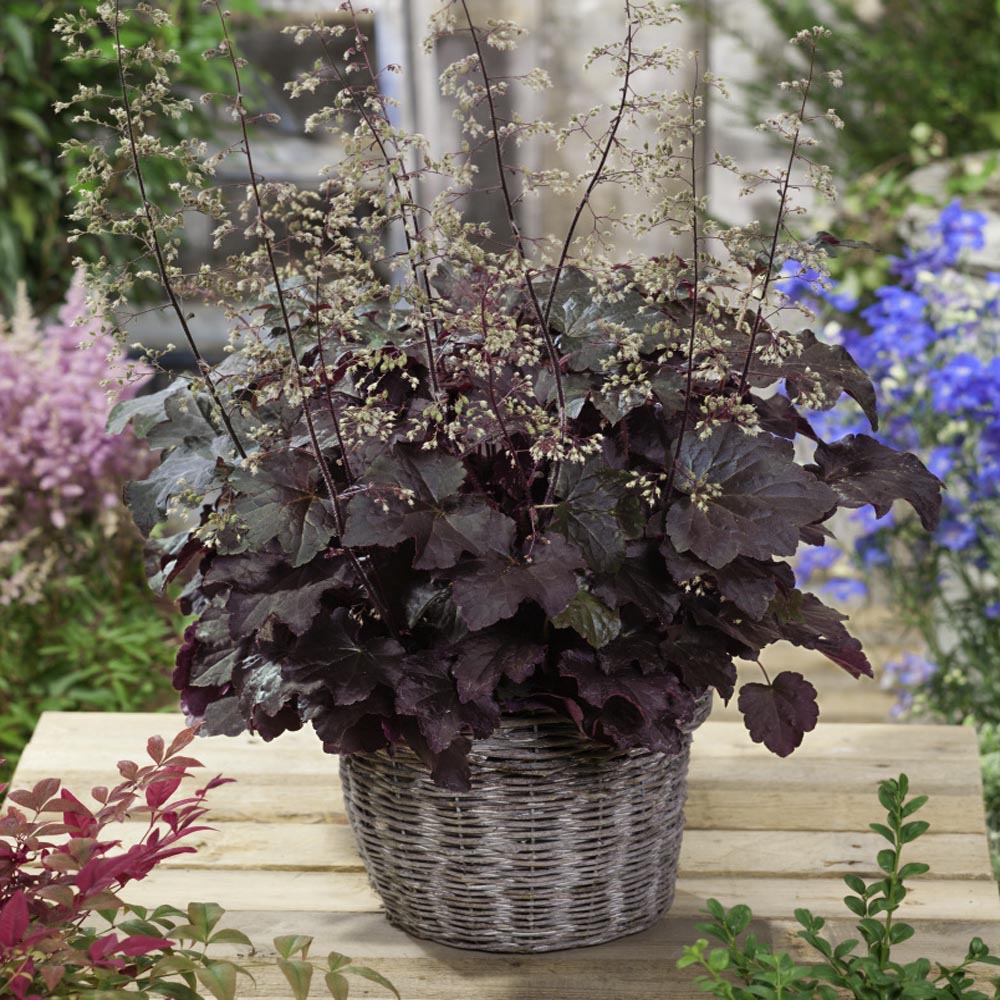
SF217 Coral Bells Heuchera Purple Palace ( Heuchera x.
micrantha )
Features very large, shiny, and star-shaped leaves, ranging in color from deep olive green to purplish-bronze. Their undersides, which are quite visible in the loosely formed clumps, are a striking metallic amethyst purple. The 20 inch tall, leafed flower scapes bear an abundance of tiny cream flowers.
Coral bells are easy to grow and blend easily with most other perennials in the landscape. Because of their low, mounding habit, they are often used as edging along paths or in containers.
Excellent in containers or borders, best if planted in groups with other foliage plants. Prefers full sun or partial shade, in well drained soil or compost. Zones 3-9
Coral bells are easy to grow and blend easily with most other perennials in the landscape. Because of their low, mounding habit, they are often used as edging along paths or in containers.
Excellent in containers or borders, best if planted in groups with other foliage plants. Prefers full sun or partial shade, in well drained soil or compost. Zones 3-9

TWT207 Autumn Bride ( Heuchera villosa macrorrhizza )
This is a shade tolerant heuchera that may be grown in rock gardens, borders, open woodland gardens, rocky slopes or native plant areas. It is best planted in groups or massed.
Its fountains of tiny, bright white panicles are set off by velvety, rounded, light green leaves. Its low-mounding form makes it excellent for planting end masse to create ground cover. Drought tolerant and deer resistant.
Space plants approximately 12 in. to 16 in. apart for best results. For best results, grow in well-drained soil. Blooms in mid to late Summer. Reaches standard mature height of 18 in. to 24 in. Tiny seeds must be started indoors. Zones 3-8
Its fountains of tiny, bright white panicles are set off by velvety, rounded, light green leaves. Its low-mounding form makes it excellent for planting end masse to create ground cover. Drought tolerant and deer resistant.
Space plants approximately 12 in. to 16 in. apart for best results. For best results, grow in well-drained soil. Blooms in mid to late Summer. Reaches standard mature height of 18 in. to 24 in. Tiny seeds must be started indoors. Zones 3-8

D9549 Tussock Bellflower ( Campanula carpatica )
Perennial. An upright perennial growing about 16 inches tall
with delightful lavender blue bell flowers all summer long.
Grows in most soils and tolerates full sun or partial
shade.
Color: Lavender Blue Zone: 3-8 Spacing:Close Height:8 inches Start Seeds: Anytime of year inside, for transplanting outside in Spring.
Color: Lavender Blue Zone: 3-8 Spacing:Close Height:8 inches Start Seeds: Anytime of year inside, for transplanting outside in Spring.

2570 Coleus Rainbow Mix ( Coleus blumei )
Easy to grow from seed. Looking for something unusual for a shady area? Rich-colored leaves in a variety of glowing shades bring a rainbow of light to partial and full shade. Try it with, or instead of, impatiens. Old-fashioned favorite is fun to grow indoors, too. 12 in. tall. Annual. Shade. Containers.
Remarkable foliage color, and easily grown from Coleus seeds, this annual mix is a reliable summer performer that gardeners depend on for their shady borders. The mix is extremely popular, and it includes a complete color range, from green-yellow, bronze and red. The seeds also can be grown for an excellent house plant which will add color to those dreary winter days. Find a sunny window sill, and Coleus plants will perform nicely indoors. Originating in Africa and Indonesia, these exotic looking plants perform well as shade garden plants, in pots and containers, and in hanging baskets. They need a partially shady setting and prefer moist, rich soil, with good drainage.
Remarkable foliage color, and easily grown from Coleus seeds, this annual mix is a reliable summer performer that gardeners depend on for their shady borders. The mix is extremely popular, and it includes a complete color range, from green-yellow, bronze and red. The seeds also can be grown for an excellent house plant which will add color to those dreary winter days. Find a sunny window sill, and Coleus plants will perform nicely indoors. Originating in Africa and Indonesia, these exotic looking plants perform well as shade garden plants, in pots and containers, and in hanging baskets. They need a partially shady setting and prefer moist, rich soil, with good drainage.

SF309 Double Athena Orange Flash
One of the fastest growing Impatiens varieties on the market, this Athena Impatiens will cover the shade garden or container quickly and beautifully! This double flowering, low-growing, long-lasting, compact Impatiens is a better spreader and bigger bloomer than many others. The flowers have a rosebud shape, very elegant in bud as well as bloom, and open to bicolor blooms of orange and white. Athena Impatiens begin flowering earlier than most other varieties, fully flowering by the time summer starts, and if maintained will continue flowering well into fall.
The leaves are dark green and very lush, and the plant spreads vigorously, scrambling across bare soil fast to show off even more blooms. Finding a plant for shade can be difficult, so look no further than this impatiens. It will only reach approximately 8 inches, but will spread 18 to 24 inches wide.
The leaves are dark green and very lush, and the plant spreads vigorously, scrambling across bare soil fast to show off even more blooms. Finding a plant for shade can be difficult, so look no further than this impatiens. It will only reach approximately 8 inches, but will spread 18 to 24 inches wide.

